本文由LOMA授权mooool发表,欢迎转发,禁止以mooool编辑版本转载。
Thanks LOMA for authorizing the publication of the project on mooool, Text description provided by LOMA.
LOMA:2019年4月17日,德国联邦园艺展(简称BUGA)在海尔布隆的夏日岛上开幕,落成的3D公园是世界上首批通过数字化设计建造的风景园。在一块大约70×500米,形状呈平行四边形的地块上,有机形状的景观波呈对角式相连,这样所形成的沙地景观包含了自然形态的沙丘、冰碛和临时性的纹理图案。随着BUGA的开幕,夏日岛上连绵起伏的景观正向公众开放,不过作为一个临时舞台,它将随着今年夏天的结束而慢慢消失。
LOMA: On the summer island in Heilbronn, one of the world’s first digitally-designed and -built landscape parks has been created for the BUGA 2019. On a plot of about 70 by 500 meters and shaped as a parallelogram, organically shaped landscape-waves join up diagonally at an angle to form a sandy landscape with natural shapes of dunes, moraines and the ephemeral patterns of a sandy landscape. The undulating landscape on the summer island will open to the public with the BUGA’s opening on 17th April 2019, but – being a temporary staging – it will fade away with the end of summer.
▼视频 Video
▼场地鸟瞰 Site aerial

一开始,这里是一个“零点” At the beginning, there was a “zero-place”
当时的夏日岛被大量的土壤所覆盖,这是因为挖掘机、大型卡车和翻斗车在这里堆积了内卡河大量的粘土质冲积土——这种材料比起用作园艺展的基础来说,其实更适合用来打造月球景观,而这样的建筑工地与夏日岛的建设构想毫无共同之处。设计师Schück谈到了“零点”,在他的想象中,自己沿着沙滩漫步,想象自己在一个夏日小岛上。沙地被溢出的波浪侵蚀,形成了潮湿而又坚硬的卷曲形状,随着下一波浪潮的涌入,沙地的面积在逐渐扩大,但是随着波浪的退去,沙地又再一次地受到了侵蚀。
At that time the summer island was covered with large piles of soil. Excavators, large trucks and tipping lorries had piled up huge depots of the river Neckar’s clayey alluvial soil here – a material more suited to creating a lunar landscape than a base for a horticultural show. The construction site had nothing in common with the dream of a summer island. Schück speaks of a “zero- place”. That is why in his imagination Schück walked along a beach visualizing himself on a summer island. He discovered the sand, which had been left damp and firm in curly shapes by the outflowing waves, only to grow in size with each new wave surging in, then gently being eroded again as it flowed back.
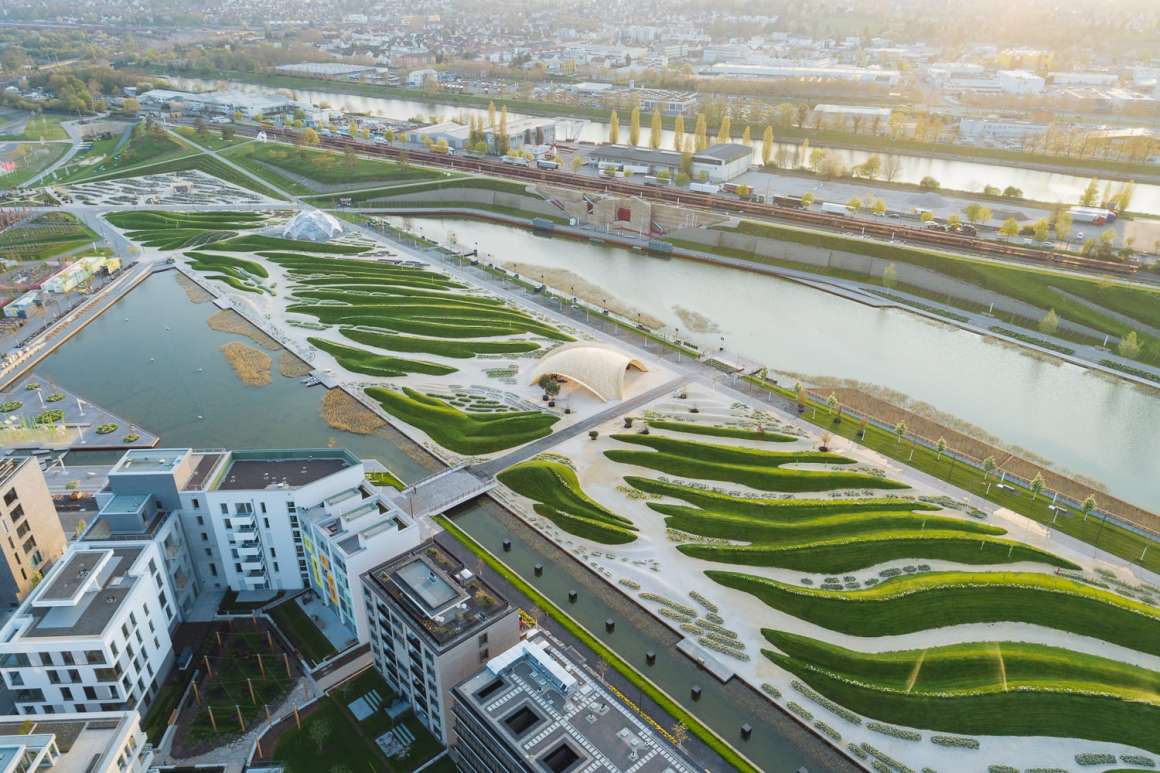

“景观(本身)是如何产生的?” “How does landscape generate (itself)?”
Schück也一直在想他的家乡和阿尔卑斯山脚下冰川形状的、起伏平缓的冰碛地貌。“风和水、移动的冰川和融化的冰对内卡河多年来堆积的土壤有什么影响?”Schück问自己,“景观是如何产生的?我们怎样才能发现大自然是以何种方式来扮演园林设计师这一角色的?这些问题吸引了我”,Schück继续说道:“如何在土壤中重现自然波浪的构造,并以创成式设计来形成波纹?”Schück研究了17世纪早期的自然科学图纸,在这些图纸中,可以看出制图员在追溯上巴伐利亚冰碛地貌景观方面有做一些努力,而Schück也尝试着在纸上勾勒出沙滩的线条,“但这看起来像是在拙劣地模仿上帝,因为你达不到他那样的程度”。
Schück, who comes from Salzburg, had, however, also been thinking of his homeland and the Alpine foothills with their glacier- shaped, gently undulating moraine landscape. “What do wind and water, sliding glaciers and melting ice do to the kind of soil that builds up at the Neckar over the years?” Schück asked himself. “How does landscape generate itself? How do we find out in what way nature acts as a landscaper? These questions appealed to me”, Schück tells and continues: “How is it possible to recreate the natural wave formation in the soil which forms ripples with a generative design?” Schück studied early drawings of natural science from the 17th century, in which cartographers had tried to trace the Upper Bavarian moraine landscape. He, too, tried to sketch the lines of the sandy beach on paper, “but that just looked like a botched attempt to copy God, because you just cannot do it like him”.
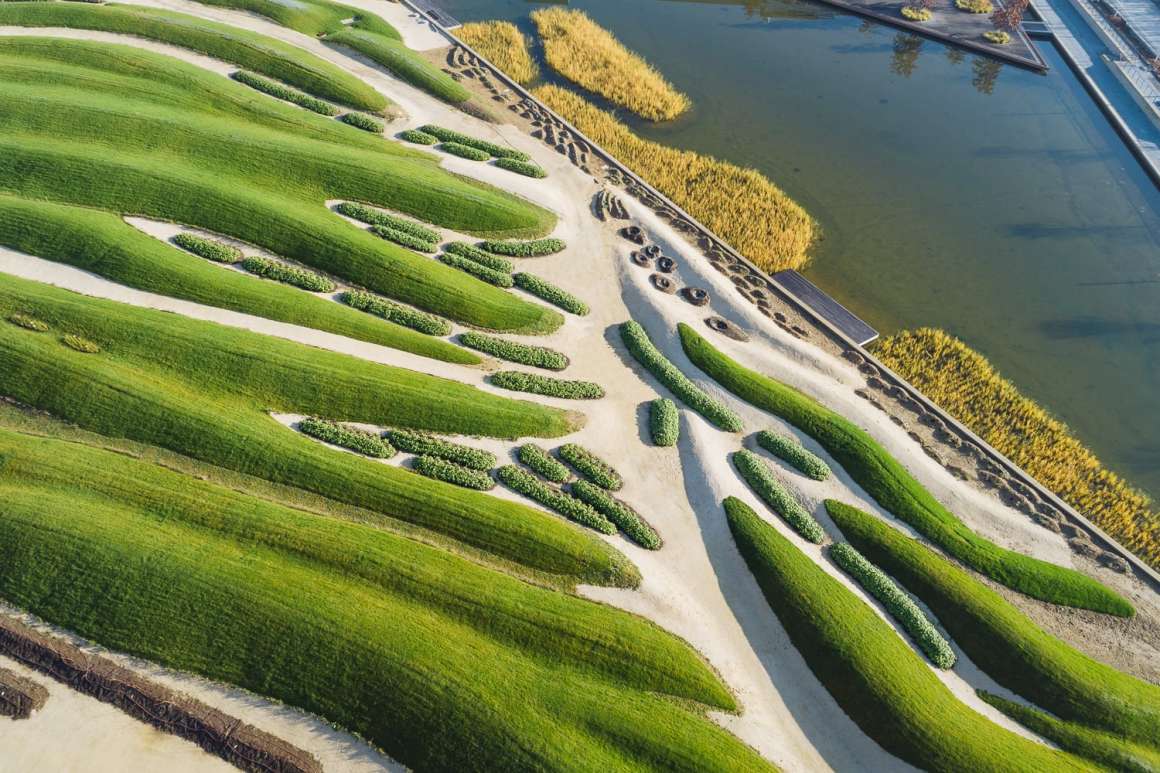
▼冰碛地形与绿色沙丘 Moraines and green dunes
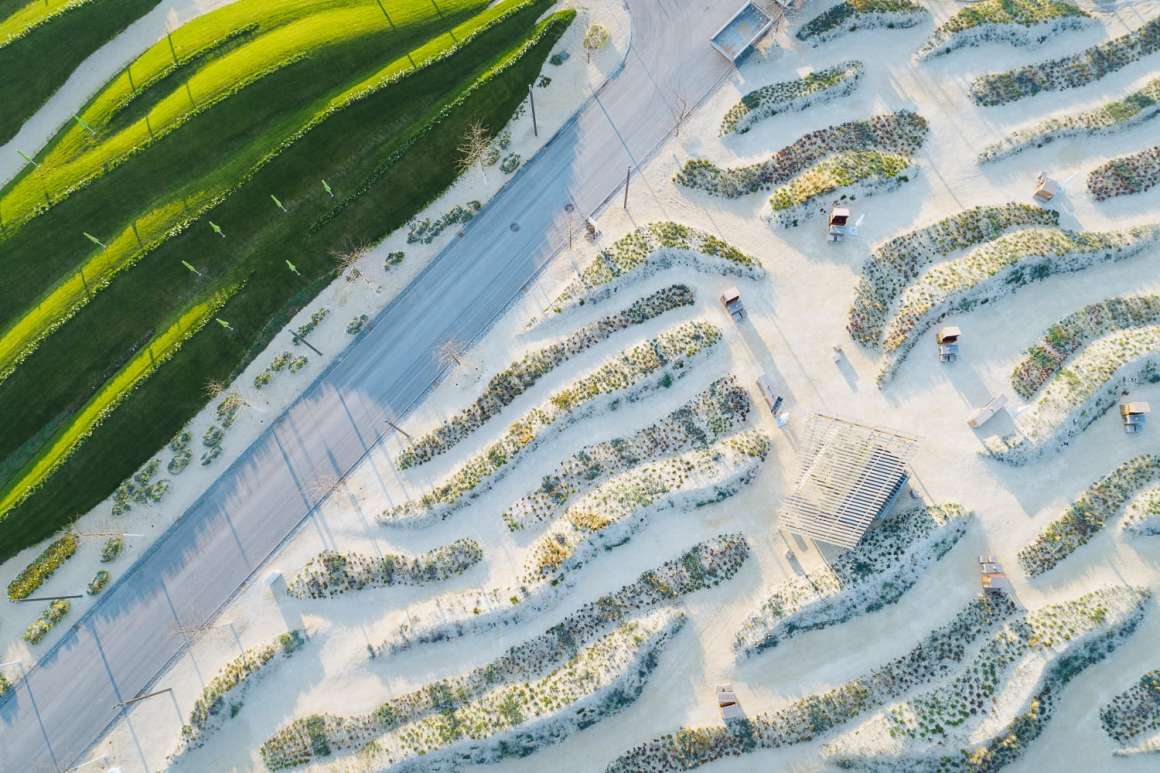
造船用的3D软件塑造了新的景观 3D-software from boat building shapes the new landscape
Schück将目光转向他自己工作室的参数化部门,与其合作伙伴Vukorep一起找到了一个解决方案:建筑师使用一种特殊的软件——Rhino 3D,将冰碛、沙丘和沙波的图纸录入电脑。建筑师佩特拉·布鲁纳霍夫(Petra Brunnhofer)也是LOMA办公室的合伙人,他说由于基本的保守主义,这个工具很少用于建筑领域,而风景园林领域更是少用。通过模仿自然来创建风景公园的概念并不新鲜,在对卡塞尔市附近的威廉斯塔尔公园进行绿化种植之前,据说兰德格雷夫的园丁们研究过上巴伐利亚州的冰碛景观,以便巧妙地塑造出公园的山丘地形。
Schück then turned to his own office’s parametrization department and found a solution with his partner Vukorep: The architects entered drawings of moraines, dunes and sand waves into the computer using Rhino 3D, a special software. According to architect Petra Brunnhofer, also a partner in the LOMA office, the tool is rarely used in architecture, however, and even less often in the field of landscape architecture, due to basic conservatism. At the same time, the concept of creating landscape parks by modeling after nature is not new. Before planting the park Wilhelmsthal near Kassel, a Rococo facility, the Landgrave’s gardeners are said to have studied the moraine landscapes of Upper Bavaria, in order to form the park’s hills as skillfully as they did.
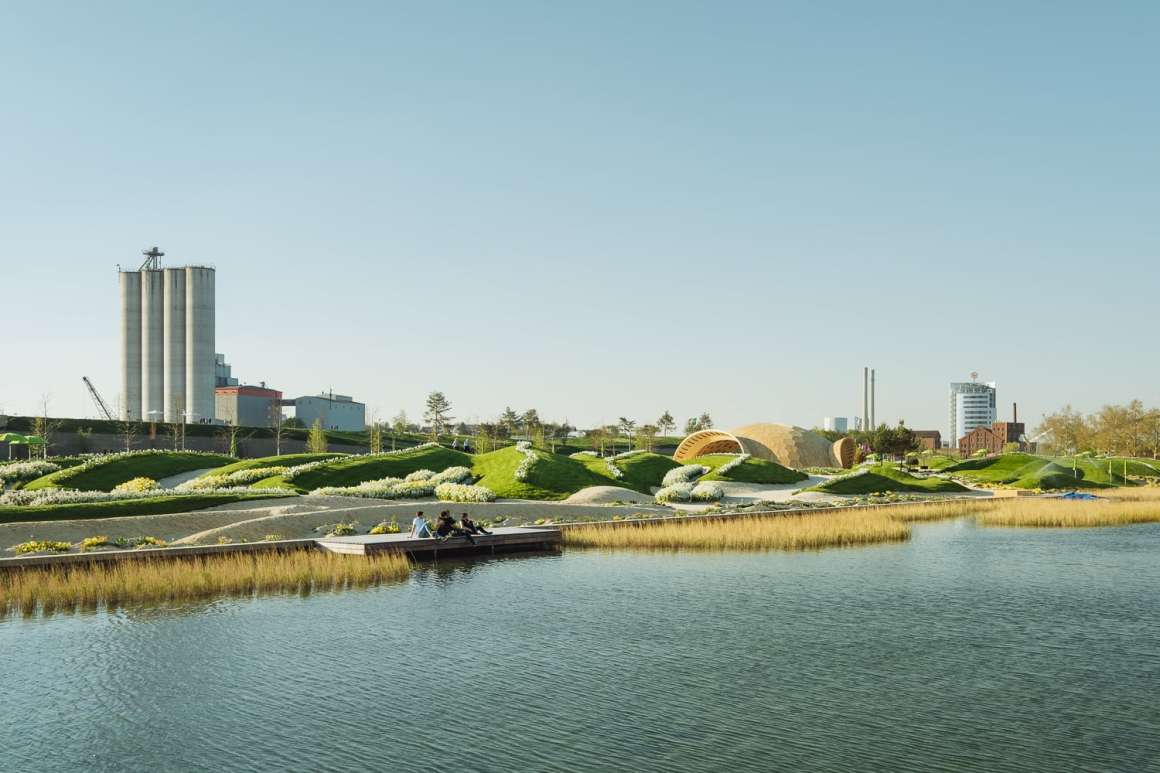

云数据中的公园 A park in a data cloud
大约300年后,Schück借助现代手段创造了一个自然景观公园。根据自然拟定的算法,LOMA团队借助3D软件将现有的堆积土壤改造成冰碛、沙丘和沙地景观。Schück没有二维的方案,而是拥有虚拟三维空间中的数百万个点云数据。为了将这些转变为现实,设计团队与卡塞尔大学景观建筑与技术系主任威伯特·瑞尔(Wigbert Riehl)教授合作,事实证明这位教授确实是一位合适的合作伙伴。早在杜伊斯堡 — 诺德风景园的建设期间,瑞尔教授就以其试验性的建造方法而闻名,到2007年,瑞尔教授和Schück首次将参数化方法引入到欧洲景观建筑的研究之中。
About 300 years later, Schück resorted to modern means of achieving an organic result in the contemporary creation of a landscaped park. According to the rules set by nature, the LOMA team had the computer transform the existing and variously piled up soil into a moraine, dune and sand landscape with the aid of the 3D software. In the end, Schück had no two-dimensional plan but a cloud with millions of data points in virtual, three-dimensional space. In order to transform these into reality, Prof. Wigbert Riehl, Chair of Landscape Architecture and Technology at the University of Kassel, proved to be a congenial partner. Already during the construction of the landscape park Duisburg-Nord, Riehl made a name for himself with his approaches to experimental construction, and by 2007 Riehl and Schück had introduced the parametric methods for the first time to the studies of landscape architecture in Europe.

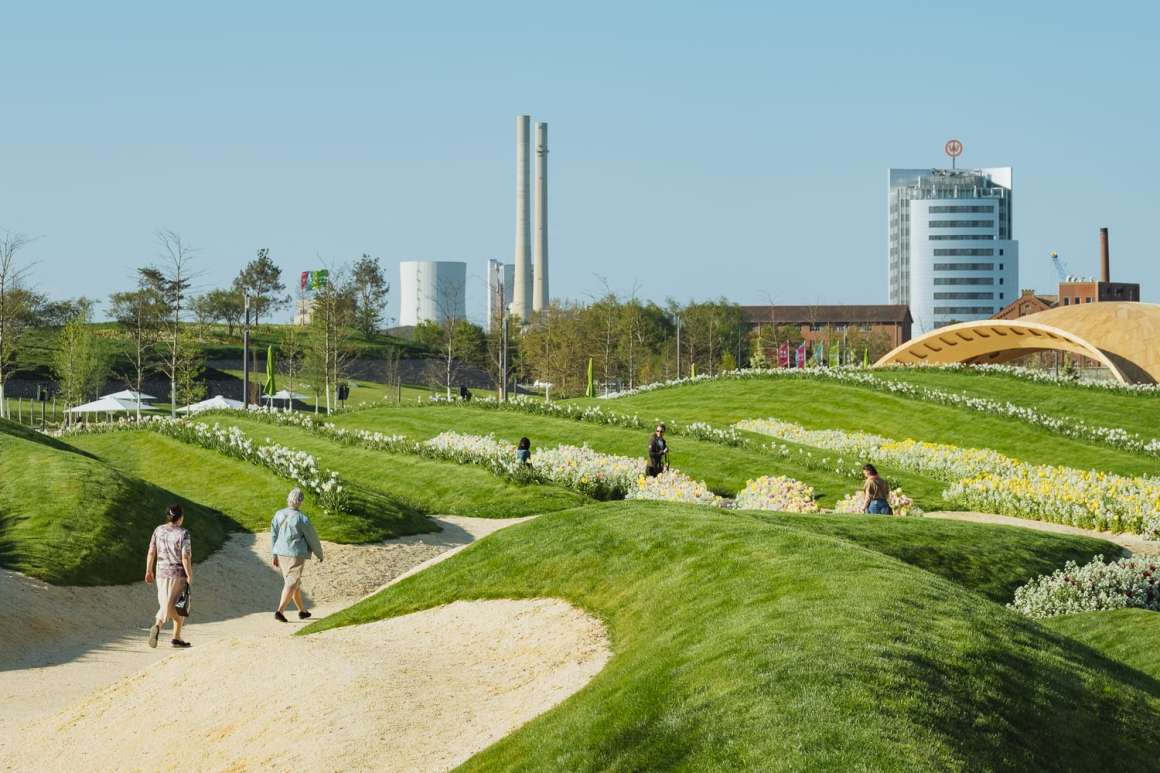
夏日岛般的景观采样 A summer island like landscape sampling
平板电脑和GPS控制器安装在夏日岛的重型挖掘机上,以真实的方式重建了虚拟景观。“这是一种新的开发方式,受技术条件的限制,之前从未以这种方式来开发过复杂的景观,园林绿化中的挖掘机与农业领域的机器仍然有较高的相似度,一切都是由驱动程序从数据矩阵中生成的”,Schück说道。当25吨重的大型挖掘机无法模拟复杂的景观时,就使用小型挖掘机。在起伏的地形上铺设了底基层和碾压式草皮,现在它就像是阿尔卑斯山麓,中间有能让人联想到沙丘的沙质通道。Schück谈到了一幅由绿色冰碛和沙丘组成的画面,内卡河的河水灌溉草坪,沙地上种植着夏季花卉和野生草本植物,这些植物耐受高温和紫外线,就像是生长在海边或高山上一样。
设计师甚至从数据矩阵中为风景园开发了一台自己的智能割草机,其旋转机并不像常见机器那样位于前方,而是被安插在下方,以链条替代车轮可以实现效果显著的越野机动性。
Tablets and GPS controls were installed in the heavy excavators used on the Summer Island and the machines’ drivers rebuilt the virtual landscape most realistically. “That was new. Because developing complex landscapes in this way had never been done before, for technical reasons. Excavators in landscaping, as opposed to machines in agriculture, are still very analog” says Schück. “Everything was generated by the drivers out of the data matrix.” Where the big 25 ton excavators could not model the intricacies of the landscape, a smaller excavator was used. A subbase and rolled sod were applied to the undulating landscape. It now resembles the Alpine foothills. In between, there are sandy passages reminiscent of dunes. Schück speaks of a picture puzzle of green moraines and sandy dunes. The lawns are irrigated with water from the Neckar, and the sandy soils are planted with summer flowers and wild herbs that tolerate heat and UV rays, as they occur at the seaside or on high mountains.
Even an own robot lawnmower was developed for the landscape park from the data matrix. Its rotary mower is not situated at the front, as is usually the case, but underneath, while chains instead of wheels allow for remarkable cross-country mobility.

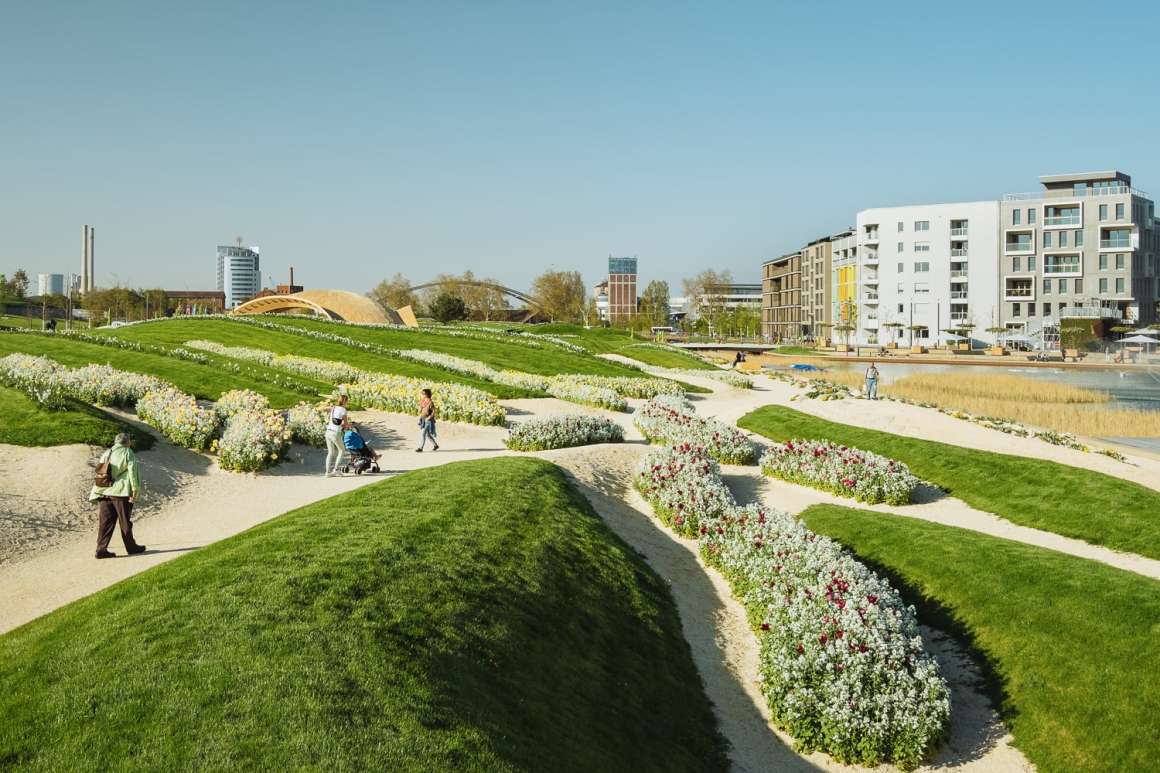
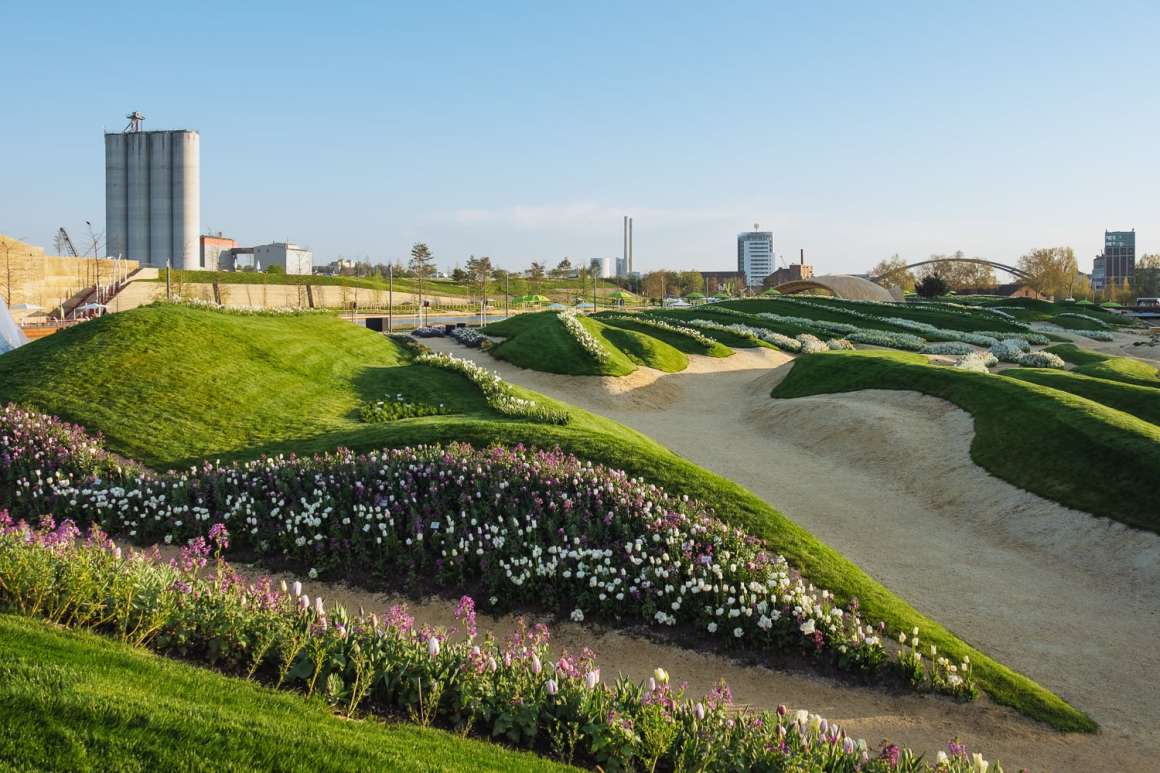
无限自由的步行雕塑 A walk-through sculpture with a massive degree of freedom
该风景园作为一个步入式的大地雕塑,形成了一个半自然的舞台,就像巴洛克时期或者后来民主时期的英国园林。这个风景园不针对任何统治者,“既没有入口也没有出口,没有小路,也没有公园长椅。除了冰碛、沙丘和沙地,还有平地和山丘可供攀爬,可以在一片绿色的‘海浪’上晒日光浴或欢快地翻滚。这个梦幻的场地把北方和南方连接在一起,普鲁士遇上了哈布斯堡,阿尔卑斯的景观设计师遇上了柏林的测量员,风景园所引发的那些民间戏言和绰号彰显了这个场地的独特性,这种景观包容着极大程度的自由”,Schück如是说,他对在内卡河河岸即将建造的房屋仍感兴奋,因为设计依旧采用数据矩阵的方式。也许观光者认为他们也可以登高望远,这样波浪景观便会在他们的脚下继续保持沉默。
The result is a landscaped park, a walk-in sculpture, which offers a semi-natural staging as in the Baroque period or later the English garden but in democratic times. The landscape is not aimed at any ruler. “There is neither an entrance nor an exit, no paths and no park benches. As well as moraine, dunes and sand there are flat areas and hills to climb, a green sea of waves to sunbathe or joyfully roll around. It is a dream-like structure that brings North and South together. Prussia meets Habsburg, the landscape architect from the Alps meets the Berlin surveyors. The mocking words and nicknames that my landscape park evokes show how unusual it is. This landscape allows a massive degree of freedom,” says Schück who is thrilled with the forms that remain as a data matrix when soon houses will be built on the Neckar bank. But, perhaps, the viewer thinks, they could also stand on stilts, so that landscape waves continue to keep silence underneath them.
▼沙地上种植着耐高温和紫外线的夏季花卉和野生草本植物,就像是生长在海边或高山上一样 The sandy soils are planted with summer flowers and wild herbs that tolerate heat and UV rays, as they occur at the seaside or on high mountains.

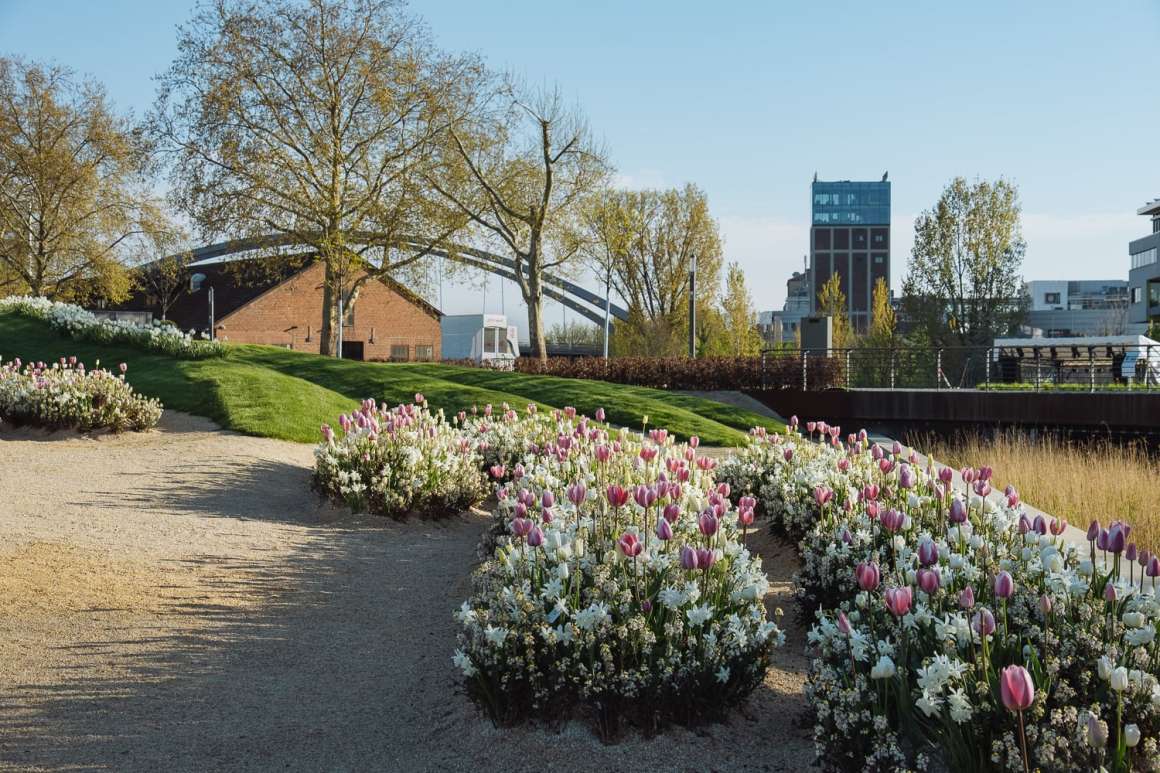
▼夜幕即将降临,场地更加宁静 Night is coming and the landscape park looks quieter.

▼设计过程 Design process
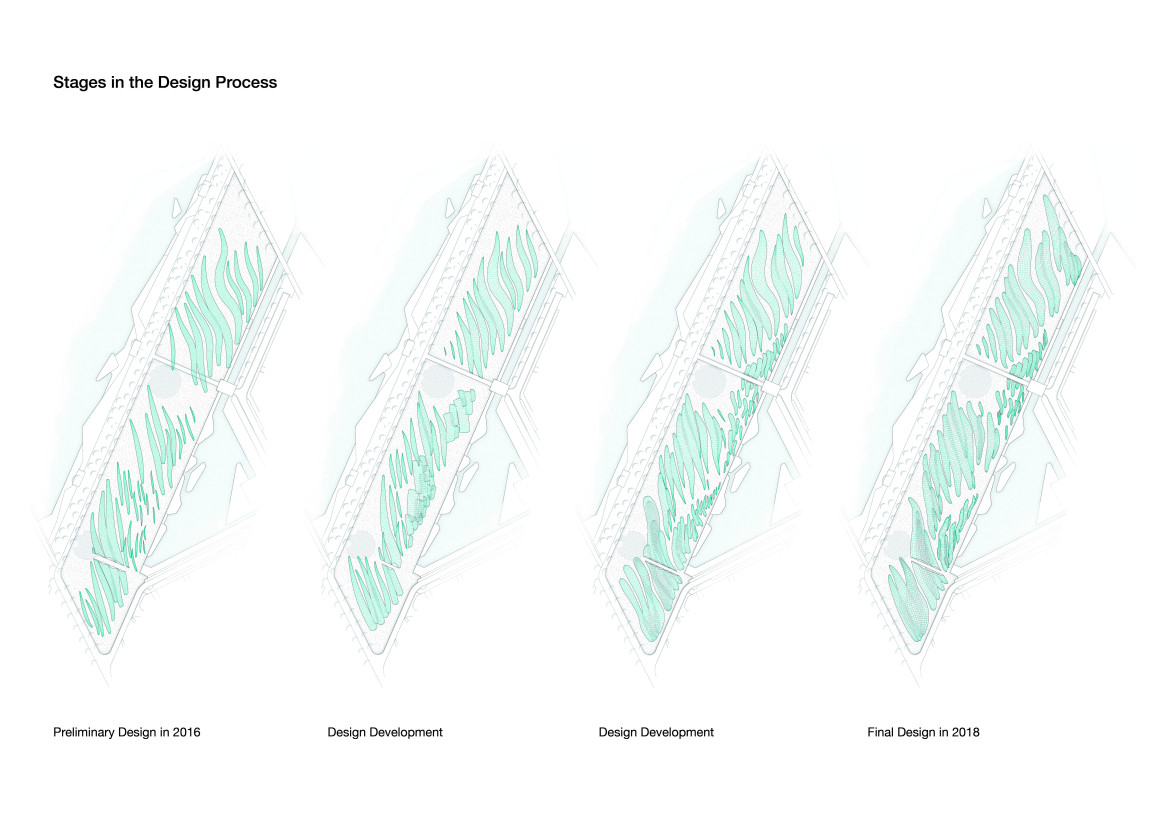
项目信息:
项目地点: 德国海尔布隆
设计时间: 2016-2019
项目设计: LOMA 建筑景观都市主义 / Brunnhofer Vukorep Schück, Kassel / 职员: Sabrina Campe, Franziska Marquardt, Hannah Hagedorn
项目监管: Riehl Bauermann + Partner landscape architects, Kassel / 职员: Kerstin Barth, Jonas Otto
照片和视频: Nikolai Benner
英文文本: Claus Müller von der Grün
Project credits:
Project location: Heilbronn,Germany
Year: 2016-2019
Design: LOMA architecture landscape urbanism / Brunnhofer Vukorep Schück, Kassel / staff: Sabrina Campe, Franziska Marquardt, Hannah Hagedorn
Supervision: Riehl Bauermann + Partner landscape architects, Kassel / staff: Kerstin Barth, Jonas Otto
Photography and Video: Nikolai Benner
Text: Claus Müller von der Grün
更多 Read more about: LOMA




在城市里玩大地艺术啊。
大地景观 nice
牛逼
犀牛不是在国外相当普及吗,19年了,参数化景观不是应该习以为常吗?
可是感觉参数化的很多是建筑或者构筑物耶。软质景观的参数化我个人蛮少见到(也可能见识少
参数化设计,秀啊,哎犀牛好难,gh好难